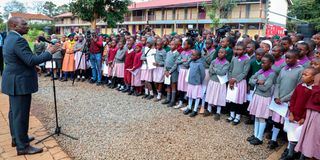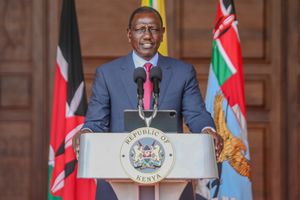Education proposals in President Ruto manifesto to cost Sh630bn

President Dr William Ruto addressing learners at Joseph Kang’ethe Primary School in Kibera, Nairobi County on November 29, 2022, during Day 2 of KCPE and KPSEA exams.
The first full school year under President William Ruto’s administration begins this month, with a focus on the implementation of ambitious reforms that experts estimate will cost at least Sh630 billion over five years.
During the launch of the Kenya Kwanza manifesto ahead of the 2022 elections, President Ruto acknowledged education is a key driver for socio-economic development and made a raft of pledges to improve the sector.
An immediate task is the recruitment of extra teachers for secondary and primary schools for which the government has committed to bridging the 116,000 shortfall. This is estimated to cost at least Sh238 billion over the next five years, according to the Parliamentary Budget Office (PBO).
Due to the huge financial undertaking in the construction of learning facilities, the new government has recommended that junior secondary be hosted in primary schools, but still finds itself in a fix over lack of laboratories as Grade 7, 8 and 9 learners need them.
Recently the President said junior high learners who have no laboratories in their schools will be allowed to access the same in the neighbouring schools.
Labs shortage
But what poses a major challenge is the revelation by PBO in its audit of the Kenya Kwanza education manifesto that 50 per cent of boarding secondary schools and 70 per cent of day secondary schools lack laboratories. This leaves the government no choice but to build them – a long-term venture that may take years to complete and which raises questions about the preparedness to roll out junior secondary.
In the short term, the government is under pressure to raise Sh28.84 billion to improve the capacity of day schools and guarantee access to quality education as congestion in the learning institutions worsens.
“The bottom-up economic transformation agenda is conscious of education as the ultimate means of ensuring an equitable society.
It ensures that every child has a chance to fulfil their potential and rise to the highest level of accomplishment irrespective of social background,” the Kenya Kwanza manifesto reads.
While the previous administration was cagey about the cost of implementing the Competency-Based Curriculum, the proposals to reform the education sector spelt out in the Kenya Kwanza manifesto offer a glimpse into the huge financial outlay.
The acid test for President Ruto’s administration, however, is to ensure a 100 per cent transition of the 1,287,597 pioneer Grade Six learners, who sat their Kenya Primary School Education Assessment last year, into junior high. Their results are due later this month.

Parents and guardians buy books for their children at Savani’s Book Centre Limited in Nairobi County on January 3, 2023, ahead of schools reopening after the December festivities.
There are also 1,244,188 pupils who sat their Kenya Certificate of Primary Education exam in November last year whose results were released in December and are waiting to join Form One this year.
This piles more pressure on the government to provide the required resources to expand both the primary and secondary education infrastructure, including the construction of classes, equipping libraries and laboratories and hiring teachers, among others.
NG-CDF cash
Already, MPs have been told to channel more of the National Government-Constituency Development Fund (NG-CDF) cash towards the improvement of schools’ infrastructure.
Towards the end of last year, President Ruto explained why he wanted the NG-CDF protected and made a constitutional fund.
Speaking on December 11, 2022, during a Church service at Wanjohi Primary School in Kipipiri, Nyandarua County, the President said NG-CDF is meant to secure the development of education.
“NG-CDF has facilitated the construction of many schools and offered bursaries for tens of thousands of learners in primary and secondary schools in the country,” the President said.
The PBO estimates that a total of 70,000 in-service teachers will be trained on an annual basis at a cost of Sh6,000 per teacher.
An estimated annual recruitment of 20,000 primary school teachers and 38,000 secondary school teachers will be undertaken, with an average annual cost of maintaining a primary school teacher at Sh300,000 and that of a secondary school teacher at Sh480,000.
The government also plans to spend Sh800,000 to build two classrooms and Sh4.5 million to construct an omnibus laboratory in each school.
It will cost Sh40 million to construct 52 teachers training institutions within two years, with the school feeding programme requiring an additional Sh1.9 billion to double the number of beneficiaries from two million to four million.
Also to eat into the government’s expenditure on education is the plan to increase the number of Early Childhood Development Education learners by 0.5 per cent, with learners provided with meals at Sh25 per day.
The Kenya Kwanza administration has also made additional commitments to promote equitable education, establishing a special tariff service for all learning institutions for basic utilities such as water, electricity and internet connection.
There is also a plan to review the current exam-based system of academic progression by implementing alternative entry criteria and setting up a national open university to increase access and reduce the cost of university education while making a 100 per cent transition to higher education a reality.
However, the plan does not indicate any financial commitment to the interventions notwithstanding that they have budgetary implications.





